Wayfinding Signage
We supply high-quality signage for Hospitality Clients all around the world.
Request a Quotation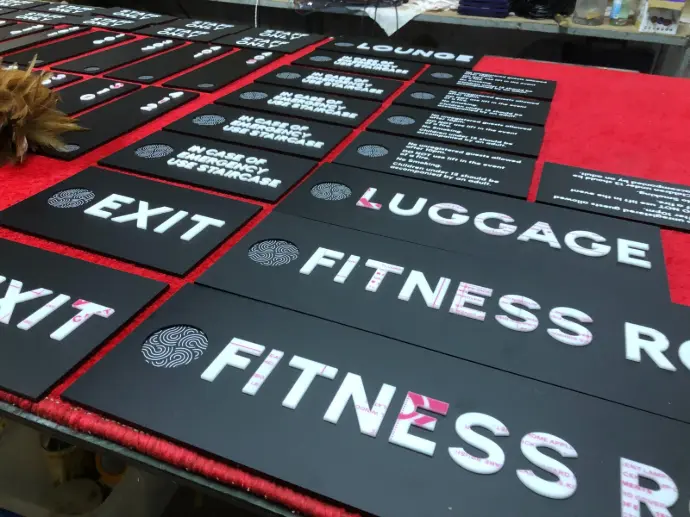
Wayfinding Signage
Wayfinding signage is a crucial element in creating a seamless and enjoyable guest experience within hotels. It acts as a silent guide, helping guests navigate the often complex layout of the property with ease. Clear and strategically placed wayfinding signs eliminate confusion and frustration, allowing visitors to effortlessly locate their rooms, amenities like restaurants and spas, and common areas such as lobbies and conference rooms. Effective wayfinding signage incorporates a logical hierarchy of information, using clear fonts, intuitive symbols, and a consistent design language. From directional arrows to interactive maps, wayfinding signage ensures that guests feel confident and comfortable exploring all that your hotel has to offer.
Importance of Wayfinding Signage
Wayfinding signage plays a crucial role in the overall functionality and guest experience within a hotel. Its impact extends beyond simple navigation, contributing to guest satisfaction, operational efficiency, and even revenue generation.
First and foremost, enhanced guest experience is a primary benefit. Clear and intuitive signage helps guests navigate the property with ease, reducing stress and anxiety. When guests can effortlessly find their rooms, amenities, or event spaces, they are more likely to enjoy their stay—leading to higher satisfaction and positive reviews.
Wayfinding signage also contributes to increased efficiency. Guests who can quickly locate their destinations spend less time wandering and more time engaging with the hotel’s offerings. This improved flow benefits both guests and staff by minimizing confusion and reducing the need for repeated directions.
Another key advantage is brand enhancement. Thoughtfully designed signage that reflects a hotel's branding—through consistent colors, fonts, and messaging—reinforces the property’s identity. This visual cohesion helps create a memorable and professional impression.
Lastly, wayfinding signage offers revenue potential. By drawing attention to restaurants, spas, shops, or special promotions, signage can subtly encourage guests to explore and spend more. Strategically placed signs highlighting services and amenities can lead to increased bookings or purchases, positively impacting the hotel's bottom line.
Key Features of Effective Wayfinding Signage
Wayfinding signage must be carefully designed to guide users effectively. The following features ensure functionality, clarity, and user-friendliness:
- Logical Hierarchy of Information
Organizing information in a structured manner is essential for effective navigation. Primary destinations, such as reception or elevators, should be prominently displayed at the top of the hierarchy, while secondary details, like room numbers or amenities, are less prominent but still accessible. This prioritization helps guests quickly identify the most relevant information at a glance. - Clear Fonts and Symbols
Fonts should be simple, legible, and suitable for viewing from a distance or under varying lighting conditions. Avoid overly decorative or complex typefaces that can confuse readers. Universally recognized symbols, such as arrows, restroom icons, and accessibility markers, provide visual cues that are easy to understand regardless of language or cultural differences. - Consistent Design Language
A consistent approach to colors, typography, and materials across all signage creates a cohesive look that enhances brand identity. This uniformity minimizes visual clutter and ensures guests can easily identify signage elements. For example, using a specific color scheme or logo placement helps reinforce the property's professional image and aids in seamless navigation. - Visibility and Contrast
Effective signage ensures high visibility and contrast between text and background, improving readability, particularly in low-light conditions. For optimal results, signage should feature bright, contrasting colors and bold fonts. Additionally, using backlit or illuminated signs ensures visibility at all times, providing an added level of convenience for guests navigating during nighttime hours.
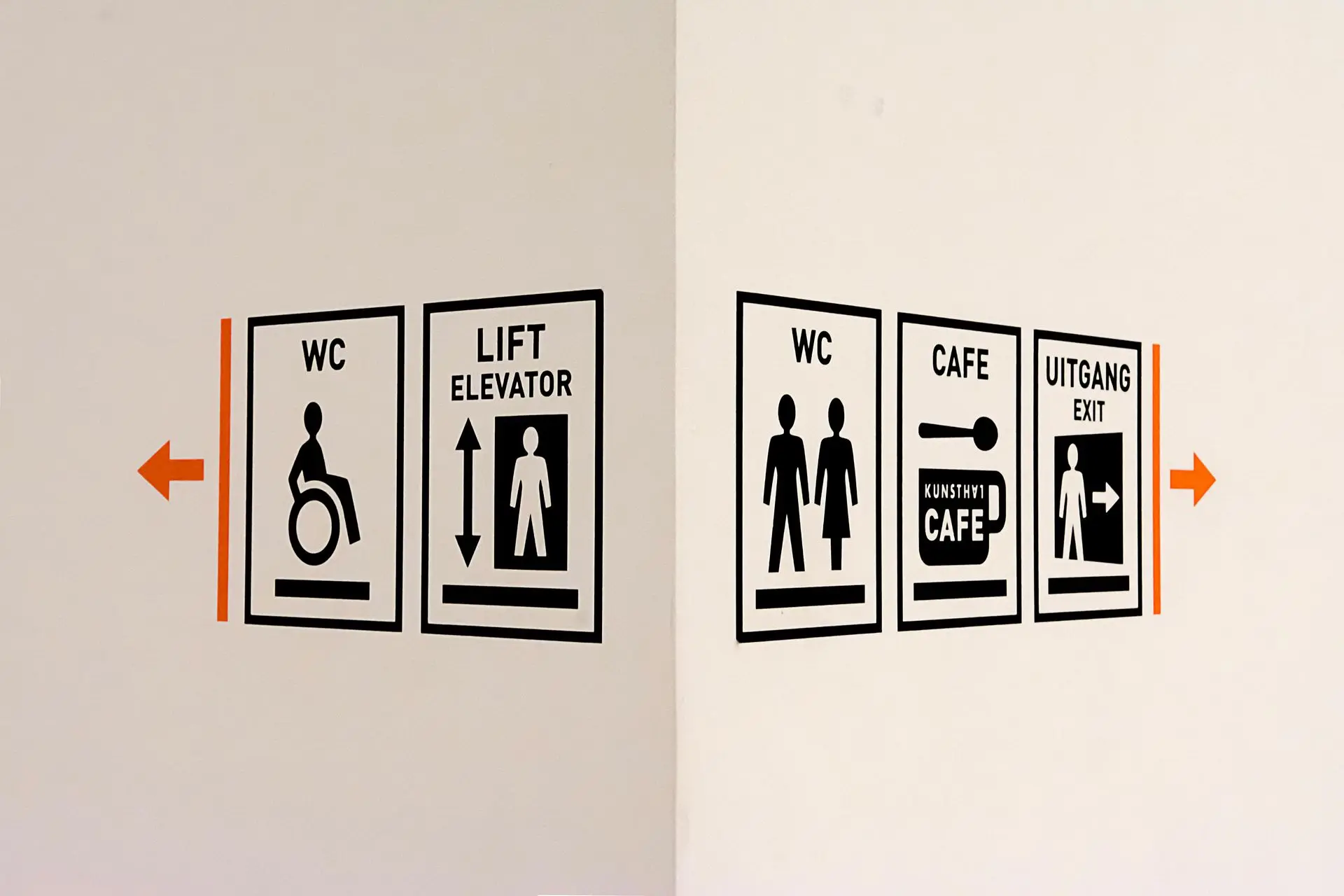
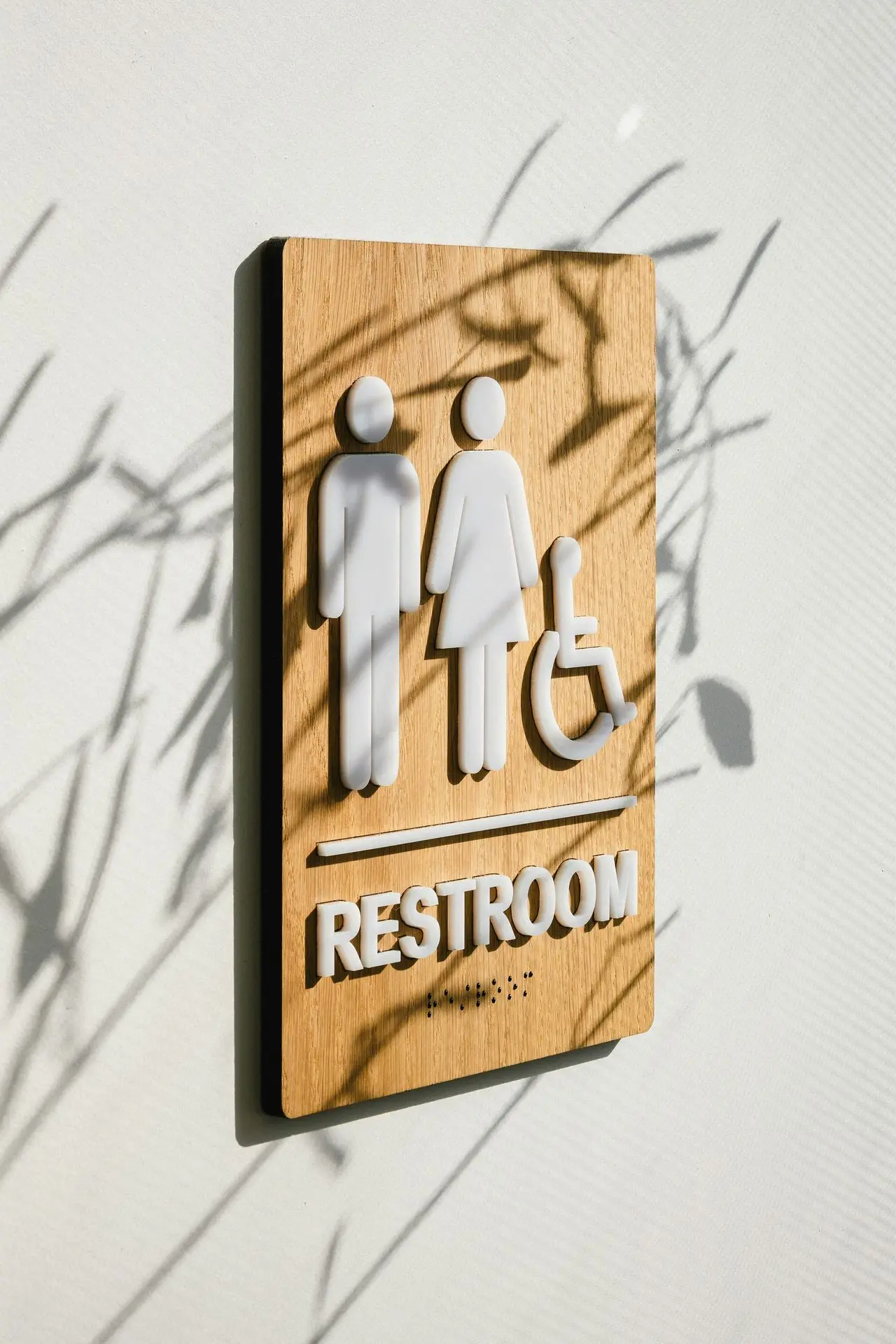
Types of Wayfinding Signage
Wayfinding signage serves as a crucial tool in guiding guests through a property, ensuring a smooth and enjoyable experience. These signs are categorized into several types, each with a distinct purpose:
- Directional Signs
Directional signs use arrows and concise text to lead guests to essential areas like lobbies, restrooms, or elevators. Positioned strategically at decision points, such as hallway intersections or near staircases, they eliminate confusion and help guests navigate efficiently. - Room Identification Signs
These signs identify rooms, suites, and meeting spaces, enabling guests to locate specific destinations easily. They often include ADA-compliant features such as raised tactile text and Braille, ensuring accessibility for all individuals. Consistency in design and placement reinforces a professional and welcoming environment. - Interactive Digital Displays
Digital displays offer modern and customizable wayfinding solutions. Equipped with touchscreens, these displays allow guests to search for locations, view property maps, and receive real-time updates on events or schedules. They are particularly useful for large or multi-purpose venues like hotels with conference centers. - Informational Signs
Informational signage provides additional details about the property, such as operational hours, safety protocols, or service descriptions. These signs often cater to diverse audiences by incorporating multilingual options, ensuring that international guests feel informed and accommodated.
Benefits of Investing in Wayfinding Signage
Investing in wayfinding signage offers numerous advantages that go beyond simply directing guests. It plays a vital role in enhancing the guest experience, streamlining hotel operations, and reinforcing a cohesive brand identity throughout the property.
One major benefit is enhancing guest confidence. When guests are presented with clear and intuitive signage, they feel empowered to navigate the property independently. This autonomy leads to a more positive and relaxed experience, allowing guests to explore amenities and services without confusion or frustration.
Wayfinding signage also helps reduce staff workload. By answering common questions about directions through signage, hotel staff can spend less time giving repetitive instructions and more time focusing on delivering personalized service. This not only improves efficiency but also enhances the quality of interactions between guests and employees.
Improving accessibility is another significant advantage. Inclusive wayfinding design, such as ADA-compliant signs and accessible layouts, ensures that all guests—including those with mobility challenges or visual impairments—can comfortably navigate the property. A commitment to accessibility demonstrates the hotel's dedication to inclusivity and can expand its appeal to a broader range of guests.
Furthermore, wayfinding signage contributes to elevating brand perception. High-quality, visually consistent signage reflects professionalism and attention to detail. Guests are more likely to associate positive attributes—such as reliability, comfort, and trust—with a hotel that prioritizes convenience through thoughtfully designed signage.
Lastly, investing in wayfinding helps increase operational efficiency. Effective signage guides foot traffic and prevents congestion in high-traffic areas, especially during peak times like check-in/check-out or large events. This organization supports a smooth flow of movement throughout the property, reducing stress for both guests and staff while enhancing the overall guest experience.
Designing Effective Wayfinding Signage
Designing effective wayfinding signage requires careful consideration of several key factors to ensure that guests can navigate a hotel with ease and confidence. Here are some essential elements to focus on:
- Clarity and Consistency: Signs should be easy to read and understand, using consistent typography and design elements throughout the hotel. This consistency reinforces the hotel's brand identity and reduces confusion, making it easier for guests to follow directions. Clear signage also helps guests quickly identify their destination, whether it's a room, a restaurant, or a meeting room.
- Strategic Placement: Signs should be placed at critical decision points, such as near elevators, staircases, and entrances. This strategic placement guides guests effectively, ensuring they know which path to take at every turn. By positioning signs at these key locations, hotels can minimize guest confusion and reduce the need for staff assistance.
- Technology Integration: Incorporating digital signage can significantly enhance the wayfinding experience. Digital displays provide dynamic information and interactive maps, allowing guests to search for specific locations, view real-time updates on events and schedules, and even receive personalized directions. This integration not only improves navigation but also offers a modern and engaging experience that aligns with the expectations of tech-savvy travelers.
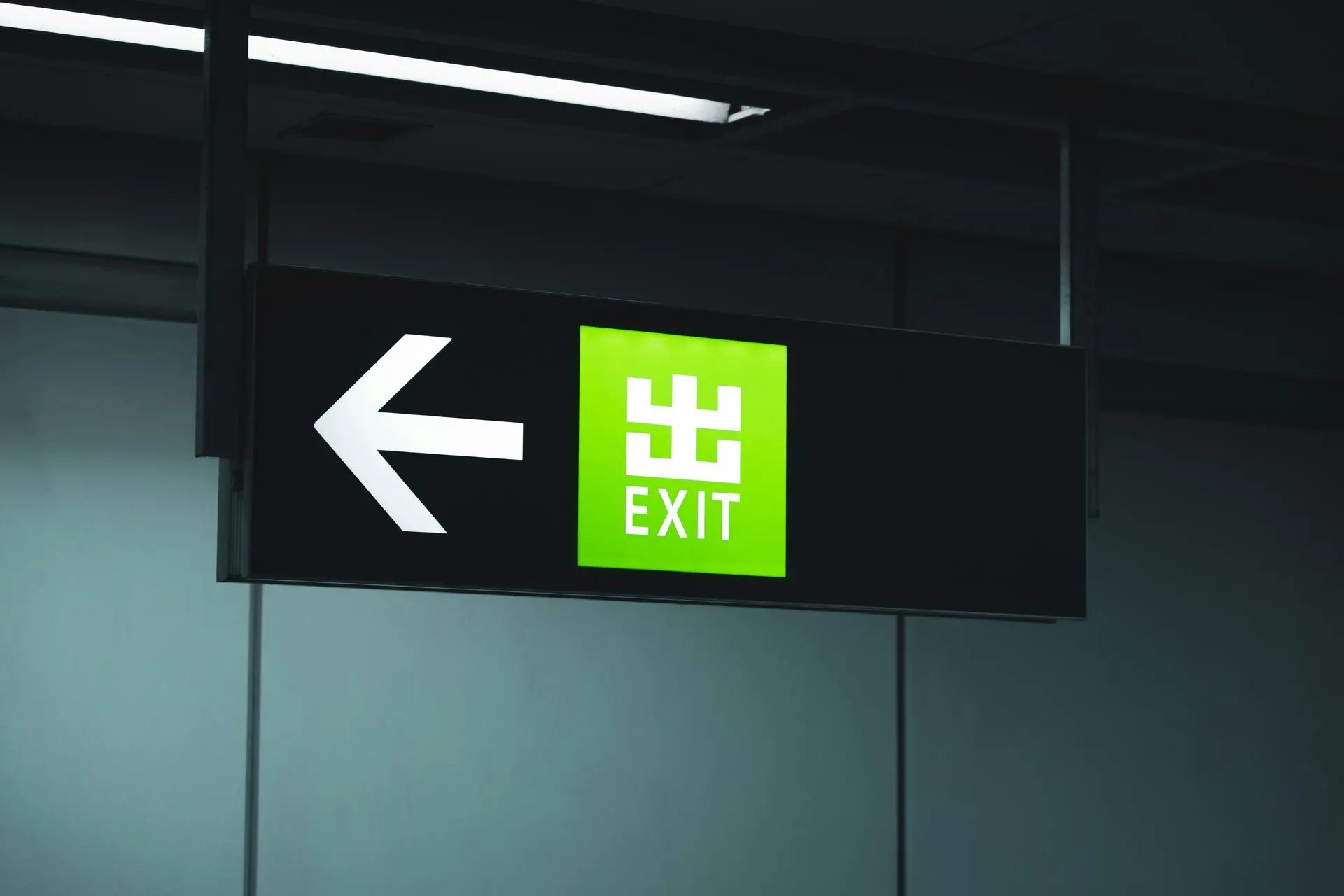
Benefits of Customized Wayfinding Signage
Investing in customized wayfinding signage offers substantial advantages that elevate the guest experience while boosting operational efficiency. Thoughtfully tailored signage serves both practical and branding purposes, making it a valuable asset for any hotel property.
One key benefit is personalization. Customized signage reflects the hotel’s unique brand identity and visual style, contributing to a cohesive and immersive guest experience. From color schemes and typography to logo placement and design motifs, personalized signage communicates the essence of the brand. This attention to detail leaves a lasting impression on guests and helps create a distinct atmosphere that sets the hotel apart from competitors.
Another advantage is enhanced guest engagement. Well-designed signage not only guides guests but also encourages them to explore more of what the hotel has to offer. By highlighting key amenities like spas, restaurants, rooftop bars, or wellness centers, signage can spark curiosity and boost guest interaction. Creative and visually appealing signs can draw attention to promotions or hidden gems within the property, increasing the likelihood that guests will take full advantage of the available services.
Customized signage also improves operational efficiency. Clear and targeted directions reduce the need for guests to ask staff for help finding rooms or amenities, minimizing repetitive inquiries and allowing employees to focus on delivering personalized service. Better guest flow throughout the property reduces congestion, especially in high-traffic areas, making daily operations smoother and more efficient.
By aligning with the hotel’s branding and addressing practical guest needs, customized wayfinding signage becomes more than just a navigational tool. It adds value to the overall guest experience, serving as an extension of the hotel’s commitment to excellence. The blend of functionality and aesthetics makes it a powerful asset in enhancing satisfaction, encouraging exploration, and streamlining operations.
Digital Wayfinding Solutions
Digital wayfinding solutions are becoming increasingly popular due to their ability to provide dynamic and interactive information. These solutions can include:
- Interactive Kiosks: Guests can use these to navigate the hotel and access information about amenities and events.
- Mobile Apps: Hotels can develop apps that provide guests with personalized wayfinding assistance and real-time updates on hotel services.
- Digital Displays: These can be used to display high-quality images of hotel amenities, creating visual interest and encouraging exploration.
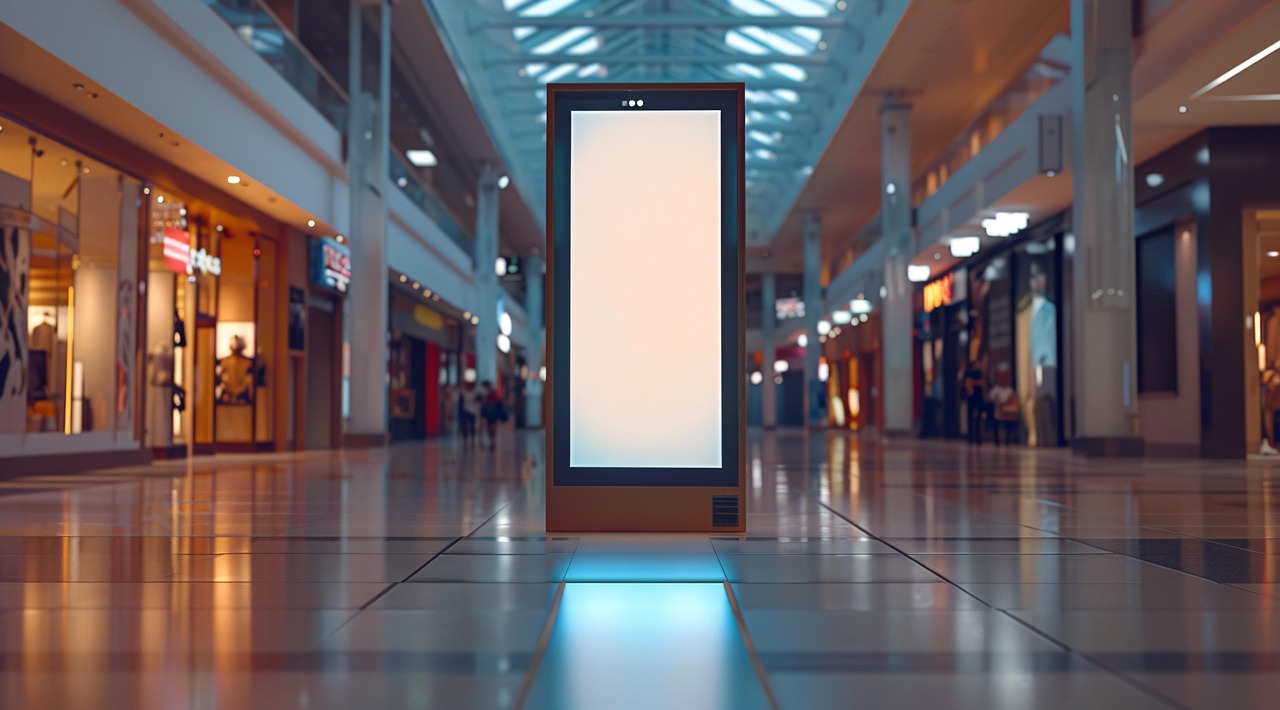
Best Practices for Implementing Wayfinding Signage
Implementing effective wayfinding signage in a hotel begins with a thoughtful and strategic approach. One of the first steps is to conduct a site analysis. This involves thoroughly understanding the hotel’s layout and identifying key decision points—areas where guests are most likely to need directional guidance, such as lobbies, elevator banks, corridor intersections, and entrances to amenities. By pinpointing these critical locations, hotels can ensure signage is placed where it will have the greatest impact.
Another essential best practice is to use clear and consistent design. All signs should follow a unified visual style, including consistent typography, colors, symbols, and branding elements. This consistency not only strengthens the hotel’s brand identity but also helps guests quickly recognize and interpret signage throughout the property, leading to a smoother navigation experience.
Finally, it’s important to test and refine the signage system. Conducting user testing—by observing how guests interact with the signage—can reveal areas of confusion or misinterpretation. Feedback and real-time observations should be used to refine the strategy, ensuring that the final signage system is intuitive, helpful, and aligned with guest expectations. By following these best practices, hotels can create a seamless wayfinding experience that enhances guest satisfaction and operational flow.
Future Trends in Wayfinding Signage
As hotels strive to enhance guest experience and stay ahead of the curve, wayfinding signage is evolving with exciting new trends. These advancements focus on technology, sustainability, and adaptability—each contributing to a smarter and more responsive guest environment.
One major trend is the integration with smart technologies. Wayfinding systems are increasingly leveraging tools like beacons and augmented reality (AR) to offer real-time navigation and personalized assistance. Guests can use their smartphones to receive step-by-step directions, tailored suggestions, or location-based notifications, making it easier to explore the property with confidence and convenience.
Another important development is the rise of sustainable signage solutions. Hotels are turning to eco-friendly materials such as recycled metals, reclaimed wood, and sustainable composites, paired with energy-efficient lighting like LEDs. These choices not only reduce environmental impact but also align with the values of environmentally conscious travelers, helping properties enhance their reputation for responsible hospitality.
A third emerging trend is the use of customizable digital displays. Advances in digital signage allow hotels to update content instantly, ensuring information like event schedules, room availability, or restaurant hours is always accurate. These displays often support multilingual content and accessibility features, making them more inclusive and user-friendly for international and differently-abled guests.
Together, these future trends are transforming wayfinding signage into a dynamic, sustainable, and highly interactive system that enriches the guest experience and supports modern hospitality goals.
Conclusion
Wayfinding signage is a vital component of any successful hotel operation. It serves as a navigational guide for guests, offering clear and intuitive directions to various hotel amenities and facilities. This type of signage not only enhances the guest experience but also plays a crucial role in improving accessibility for individuals with diverse needs. Additionally, wayfinding signage helps reinforce your hotel’s brand identity by seamlessly incorporating your brand’s colors, fonts, and visual elements into the design. Thoughtfully designed wayfinding solutions can elevate guest satisfaction, reduce confusion, and create a more organized and efficient hotel environment.
In the competitive hospitality industry, providing an intuitive and user-friendly navigation experience can significantly contribute to the overall reputation of your property. It reflects professionalism, attention to detail, and a commitment to guest comfort. At Deper Hospitality, we specialize in crafting innovative and high-quality wayfinding signage tailored to meet the unique needs of your hotel. Our team of experts collaborates closely with you to design customized signage solutions that align with your brand, enhance the guest experience, and exceed expectations. Whether you need directional signs, digital displays, or accessible signage, we are equipped to provide exceptional results.
Contact us today to learn more about our wayfinding signage solutions. Let us help transform your hotel into a more welcoming, accessible, and navigable space, ensuring that every guest’s journey is as memorable as their stay.
Ready to embark on a journey redefined hospitality products?
Contact us today to learn more about our customization options and to request a quote.